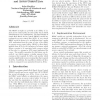Free Online Productivity Tools
i2Speak
i2Symbol
i2OCR
iTex2Img
iWeb2Print
iWeb2Shot
i2Type
iPdf2Split
iPdf2Merge
i2Bopomofo
i2Arabic
i2Style
i2Image
i2PDF
iLatex2Rtf
Sci2ools
113
click to vote
RBAC
1997
1997
Comparing simple role based access control models and access control lists
The RBAC metaphor is powerful in its ability to express access control policy in terms of the way in which administrators view organizations. The functionality of simple Role Based Access Control (RBAC) models are compared to access control lists (ACL). A very simple RBAC model is shown to be no di erent from a group ACL mechanism from the point of view of its ability to express access control policy. RBAC is often distinguished from ACLs by the inclusion of a feature which allows a session to be associated with a proper subset of the roles (i.e., groups in ACL terms) authorized for a user. Two possible semantics for this feature are described: one which requires a similar amount of processing as that required by ACLs, and another which requires signi cantlymore processing than that required by ACLs. In addition, the capability to de ne role hierarchies is compared to an equivalent feature in ACLs.
Related Content
| Added | 01 Nov 2010 |
| Updated | 01 Nov 2010 |
| Type | Conference |
| Year | 1997 |
| Where | RBAC |
| Authors | John F. Barkley |
Comments (0)

